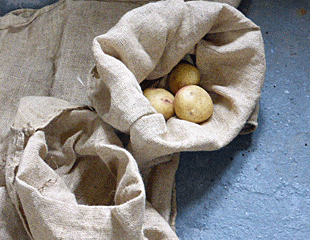
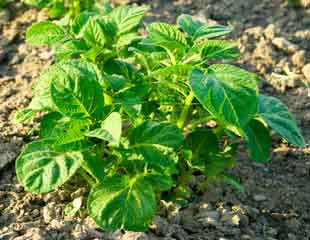
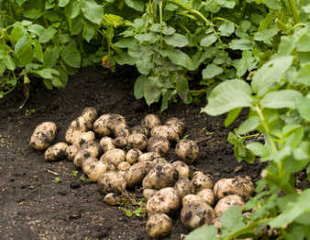
How to Grow Potatoes
Potatoes are one of the easiest vegetables to grow.
There are three main types of potato to grow determined by when you plant and harvest them.
- Earlies, as the name suggests are the first to be planted and early to harvest. You can plant Earlies from March onwards, they will crop in June/July. These new potatoes are best lifted and eaten straight the way as they do not store well. Popular varieties of Earlies are: Swift, AAron, Duke of York, Orla, plenty to choose from.
- Second Earlies are planted later in April and will crop in around July/August. Second Earlies are very popular as this group include many of our potato favourites such as Charlotte, Nicola, Anya, kestrel, Jazzy all of which I have grown with good success.
- Maincrop are the last potatoes to be planted and harvested. These tend to be larger potatoes used for baking, mashing and chips. Plant mid to late April and harvest sept/October.
There is detailed planting advice below, but remember the top growth, called Haulm, is frost sensitive. This means if you have planted early, or the plants have put on spurge and the foliage is above the soil and bad weather is threatened, you will need to protect the top growth from frost.
An advantage of growing first and second earlies is that they tend to crop early in the year before blight makes its unwelcomed appearance.
Once Potatoes are growing and the foliage (haulm) earth up regularly, (see below) water potatoes during dry periods, and feed them, if you have time. If it is a reasonable summer with no blight, potatoes will grow with little attention.
One of the main problems when growing potatoes is blight, which is described below. Essentially, it is an air-borne fungus which will strike if the conditions are right. Generally, this is a spell when it is warm and damp, and unfortunately there is no real cure for blight.
Best tips for growing potatoes:
- Plant is a sunny spot in soil/containers with good soil enriched with organic matter.
- Start with good quality seed potatoes.
- Always earth up potatoes even when growing in pots.
- Take great care not to damage the top growth, especially when earthing up.
- Water well, potatoes need a good amount of rain to grow well and feed regularly.
- If you live in a blight prone area, see below, grow the blight resistant varieties of Potato.
Chitting Potatoes
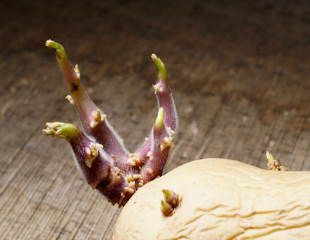
In Jan/Feb, some weeks before you are ready to plant out the potatoes, lay them on paper in a light cool room away from direct sunlight to allow the tubers to form shoots, as in image left. Chitting is the first step to growing potatoes. If you have time it is good to do but it is not essential to a good crop.
Keep the potatoes out of direct sunlight in a cooler area, too much warmth and the shoots will be leggy. Chitting takes around 6 weeks by which time the shoots should be around 2.5cms long.
How and When to plant potatoes
It is advisable not to grow potatoes in the same area of the garden or veg plot each year or where you have grown tomatoes previously (which are the same family, Solanum) because of the risk of diseases. Rotate the various crops, including potatoes and tomatoes.
Ideally, to reduce the risk of disease, if space allows it is better not to grow any of the same veg in the same bed each year. For more information about which vegetables belong to the same family growing group and how to rotate your veg crop, see Crop Rotation.
In the Veg Plot
- March plant first Earlies 30cms apart in rows 60 cm apart. It is easier to dig a trench and plant into the trench.
- April second Earlies same spacing
- Late April Plant Maincrop 35cms apart and in rows or trenches 70 cm apart.
In containers:
Potatoes take up a lot of room in the veg plot, which is why many gardeners grow them in containers. Potatoes are an ideal crop for a large container. It is important to pick a large container, at least 40 litres, and ensure it has good drainage holes. Place 3 or 4 tubers in each pot with 15-20cms of good compost in the bottom and cover with 10 cm of compost. Keep adding layers of compost and earthing up as they haulms develop. If you have chitted the potatoes handle carefully so as not to damage the shoot and plant with the shoots upwards, if possible.
Earthing up and Haulms
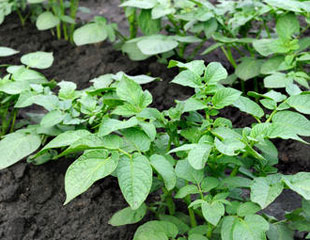
If you plant out early or we have late frosts, you need to protect the top growth, called haulms, from frost. Potatoes are not frost hardy (What does "frost hardy" mean?) As soon as the shoots appear earth up or cover the growth by adding more soil in the pot.
However, frost protection is only one reason for earthing up, it's not the only reason. It is more fundamental. "Earthing up" which means as the top growth appears, extra soil is added to the pot, or scraped up around the potatoes if in the ground, to form a mound and continue with earthing up as the potato grows, (see image left.)
Video explaining earthing up potatoes and discussing Potato blight.
Earthing up increases the depth of soil. The potatoes form under the soil beneath the plant, so a good depth of soil or compost makes for more potatoes. If the potatoes are in the veg plot, earth up to create raised ridges up to 30 cm. Earthing up will help to increase crop yields and offer some protection against blight. In containers, add soil carefully and scrape up the Haulms to earth up.
It also helps to keep the potatoes in the dark so that the tubers do not become green.
Slug attack
Potatoes can be prone to attack from slugs. These are a type of slug which live in the soil, underground all the year round. This means that slug pellets and other surface barrier methods of slug control are ineffective. To dispose of these types of slugs, it is best to use Nematodes, which are a biological method of slug control watered into the soil. How to use Nematodes.
Potato Blight
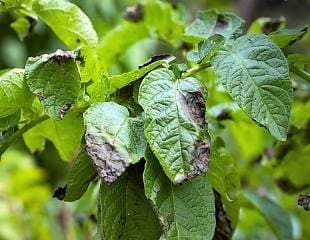
Potato Blight is a problem. Blight is an air bourne fungus type disease which attacks the foliage (and later the tubers) causing it to collapse. It commonly occurs in wet, mild and humid conditions and is difficult to manage. Blight can affect tomatoes as well, although if grown in a greenhouse this will afford protection as it is mainly, but not exclusively, a disease which affects out door crops. Blight starts with brown marks on the leaves, image left and quickly spreads so that all the foliage turns brown or black collapses and the plant looks patently sick. Once it takes a hold, there is not much that can be done as it spreads rapidly.
Good air circulation can help. Whenever space allows, do not plant the tubers too close together. In addition, follow crop rotation because the fungus can overwinter in any tubers left in the soil and reinfect. This is an additional reason why you should remove all potatoes at the end of the season, including any tiny ones.
One way, perhaps the only way, to avoid blight is to grow Blight resistant potato varieties. This does not guarantee that Blight will not visit, but much reduces the chances. The most commonly sold Blight resistant varieties is the Sarpo range. Late varieties of potato are more prone to blight. Earlies and salad potatoes may escape as the warmer humid temperatures required for blight are more likely to occur later in the year. In the eastern parts of the UK and drier areas, it is less of a problem, and it is no coincidence that potatoes are grown in Lincolnshire. It is the humid, warm air which allows the pathogen to spread, and it can destroy a crop in a couple of weeks.
If the plant becomes badly infected, the only possibility is to cut off all the infected leaves close to soil level and be careful to pick up all bits of infected leaves. If the blight has not reached the tubers, they can still be harvested.
Potatoes can get scab, which makes them look unattractive, but they are edible and not noticeable when peeled. This tends to be more of a problem on thin chalky soils, which are prone to drying out the addition of organic matter will reduce the risk of scab.
Planting for Christmas
It is possible to plant potatoes in August for harvesting later in the year for Christmas dinner. Buy seed potatoes sold as Christmas or winter potatoes and they are best grown in containers so you can bring them into a greenhouse, undercover or shelter to protect from frost. These potatoes do not need to be chitted before planting.
Plant into the container in the usual way in late August /Early September. Use the same type of container and compost as you would normally. Water in dry spells and avoid wetting the leaves, which antagonises the blight around late September/October if it is warm and wet.
The top growth is frost sensitive, protect with a fleece or bring under glass into the greenhouse. These potatoes will be ready to harvest about 12 weeks after planting.
When to Harvest Potatoes
Check once the plants are flowering. This is a sign the crop is ready. If you have planted in the ground, take care when you harvest not to spear the potatoes with the fork and to clear them all out of the ground, including the tiny ones, to prevent weak seedlings from growing the following year.
Earlies can be lifted as soon as the flowers appear as can salad potatoes.
Maincrop can be left in the ground much longer even after flowering. Towards the end of the season, cut off the top growth from Main crop, leave for about 2 weeks and lift and store somewhere cool and dark. Hessian sacks are good for storage as they allow air circulation. Potatoes need to be stored in a frost free place and it is important to exclude light. It is important the Potatoes are completely dry before storing. Maincrop potatoes will keep and store for longer than earlies.
last updated 24.01.2024
